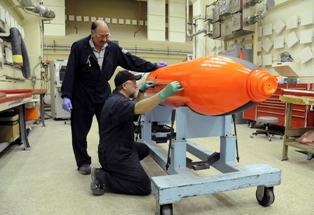Mock Weapons Built at Pantex Test Deterrent Capabilities
Joint Test Assemblies heighten confidence in nuclear stockpile
 A mock nuclear weapon leaves California aboard a Minuteman III intercontinental ballistic missile. Radars in the United States and across the globe pick up its movement. Minutes later, the mock W87 plummets to earth over Kwajalein Island. Though it carries no special nuclear materials and, as such, is not capable of a nuclear yield, the value of this JTA is beyond measure.
A mock nuclear weapon leaves California aboard a Minuteman III intercontinental ballistic missile. Radars in the United States and across the globe pick up its movement. Minutes later, the mock W87 plummets to earth over Kwajalein Island. Though it carries no special nuclear materials and, as such, is not capable of a nuclear yield, the value of this JTA is beyond measure.
Information gathered from the weapon’s sensors and instrumentation allows scientists and engineers from national laboratories to assess its performance to ensure that the weapon
functions as designed. This vital program enables the laboratories to annually validate the effectiveness of the nuclear stockpile to the President of the United States.
The Joint Surveillance Flight Test Program, under which JTAs are administered, is a collaboration between the NNSA and the Department of Defense. Testing has been ongoing for the life of the stockpile, and there are currently JTAs for all weapons except the W84, for which testing was discontinued several years ago.
“The labs design the JTAs, and we build and ship them to the military for test flights,” said Curtis Chamberlain, Pantex Production manager. “We also do post mortem or disassembly of the JTA after the flight on the B61, B83 and W80.” Others, such as the high-fidelity JTA, which use main charge high explosives, are destroyed on impact, though data gathered during the JTA’s flight is transmitted to naval ships or to ground stations.
Building the JTAs is a more detailed process than building a full-up nuclear weapon, according
to Chamberlain, because of the telemetry or “brains” that measure performance. Unlike protocol for production technicians elsewhere onsite, those working on JTAs can work alone and call on others for assistance when needed. “These guys are meticulous,” said Chamberlain.
“The most challenging part of these builds is the uniqueness of each build within the same
program. With those challenges comes the most rewarding part of building these units — we
confront and address each challenge and get the job done,” said Trey Gillman, Production section manager. “The production techs I have worked with and now supervise are some of the best on Plant site, and I consider that one of the biggest rewards also.”
JTAs are built using parent-unit parts to test their in-flight capabilities along with off-the-shelf and
vendor-supplied components, explained Ronnie Navarrette, Production Tooling department manager and former Production manager over the JTA program.
Technicians see the process from beginning to end — times four. Parts from recovered JTAs
may be used as many as three times if the mock weapon is dropped using a parachute. At their
fourth use, the parts are used on JTAs that are sent into free fall.
“JTAs are one of our end products, and I like the fact that they are actually used by our military,”
said Navarrette. “I like the deterrence value that they provide, playing an important role in
the security of our nation. And, they leave some fascinating contrails behind.”
